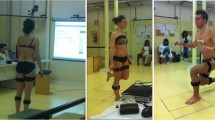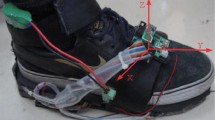Abstract
Previous research on spinal motion during walking has been restricted to the level walking condition in a gait lab although staircase walking (i.e., stair ascent and descent) exhibits unique biomechanical characteristics. A major difficulty in spinal motion capture during staircase walking is the in-the-lab limitation of measurement techniques. The purpose of this article is twofold: (i) to present an ambulatory spinal motion measurement system based on inertial and magnetic sensors (IMSs) to overcome this limitation and (ii) to demonstrate its application to 3D spinal motion analysis during staircase walking to fill a gap in the spinal kinematics literature. The proposed system is comprised of three tri-axial IMSs on the pelvis/spine measuring 3D angular motions of the pelvis, lumbar spine and thoracic spine and two uni-axial gyroscopes on the shanks providing gait cycle information. The proposed system was employed in comparing the spinal motion during the staircase walking to that of the level walking with respect to the motion pattern, variability, and range of motion (ROM). The test results showed clear differences in spinal motion between the level walking and staircase walking conditions, particularly in regards to the motion pattern and ROM of the flexion/extension and lateral bending of the spine.




Similar content being viewed by others
References
Aminian K, Najafi B, Bula C, Leyvraz P, Robert P (2002) Spatio-temporal parameters of gait measured by an ambulatory system using miniature gyroscopes. J Biomech 35:689–699
Bergmann JH, Mayagoitia RE, Smith I (2009) A portable system for collecting anatomical joint angles during stair ascent: a comparison with an optical tracking device. Dyn Med 8:3
Chan PY, Wong HK, Goh JCH (2006) The repeatablity of spinal motion of normal and scoliotic adolescents during walking. Gait Posture 24:219–228
Coley B, Najafi B, Paraschiv-Ionescu A, Aminian K (2005) Stair climbing detection during daily physical activity using a miniature gyroscope. Gait Posture 22:287–294
Crawford NR, Yamaguchi GT, Dickman CA (1999) A new technique for determining 3-D joint angles: the tilt/twist method. Clin Biomech 14:153–165
Cutti AG, Giovanardi A, Rocchi L, Davalli A, Sacchetti R (2008) Ambulatory measurement of shoulder and elbow kinematics through inertial and magnetic sensors. Med Bio Eng Comput 46:169–178
Cutti AG, Ferrari A, Garofalo P, Raggi M, Cappello A, Ferrari A (2010) ‘Outwalk’: a protocol for clinical gait analysis based on inertial and magnetic sensors. Med Biol Eng Comput 48:17–25
de Vries WHK, Veeger HEJ, Baten CTM, van der Helm FCT (2009) Magnetic distortion in motion labs, implications for validating inertial magnetic sensors. Gait Posture 29:535–541
Ferrari A, Cutti AG, Garofalo P, Raggi M, Heijboer M, Cappello A, Davalli A (2010) First in vivo assessment of “Outwalk”: a novel protocol for clinical gait analysis based on inertial and magnetic sensors. Med Biol Eng Comput 48:1–15
Giansanti D, Maccioni G, Benvenuti F, Macellari V (2007) Inertial measurement units furnish accurate trunk trajectory reconstruction of the sit-to-stand manoeuvre in healthy subjects. Med Bio Eng Comput 45:969–976
Goodvin C, Park EJ, Huang K, Sakaki K (2006) Development of a real-time three-dimensional spinal motion measurement system for clinical practice. Med Biol Eng Comput 44:1061–1075
Krebs DE, Wong D, Jevsevar D, Riley PO, Hodge WA (1992) Trunk kinematics during locomotor activities. Phys Ther 72:505–514
McFadyen BJ, Winter DA (1988) An integrated biomechanical analysis of normal stair ascent and descent. J Biomech 21:733–744
Moreno JC, Brunetti F, Rocon E, Pons JL (2008) Immediate effects of a controllable knee ankle foot orthosis for functional compensation of gait in patients with proximal leg weakness. Med Bio Eng Comput 46:43–53
Riener R, Rabuffetti M, Frigo C (2002) Stair ascent and descent at different inclinations. Gait Posture 15:32–44
Rowe PJ, White M (1996) Three dimensional, lumbar spinal kinematics during gait, following mild musculo-skeletal low back pain in nurses. Gait Posture 4:242–251
Saunders JB, Inman VT, Eberhart HD (1953) The major determinants in normal and pathological gait. J Bone Joint Surg Am 35:543–558
Schepers HM, Roetenberg D, Veltink PH (2010) Ambulatory human motion tracking by fusion of inertial and magnetic sensing with adaptive actuation. Med Biol Eng Comput 48:27–37
Syczewska M, Oberg T, Karlsson D (1999) Segmental movements of the spine during treadmill walking with normal speed. Clin Biomech 14:384–388
Taylor NF, Goldie PA, Evans OM (1999) Angular movements of the pelvis and lumbar spine during self-selected and slow walking speeds. Gait Posture 9:88–94
Thurston AJ, Harris JD (1983) Normal kinematics of the lumbar spine and pelvis. Spine 8:199–205
Whittle MW, Levine D (1999) Three-dimensional relationships between the movements of the pelvis and lumbar spine during normal gait. Hum Mov Sci 18:681–692
Winter DA (1984) Kinematic and kinetic patterns in human gait: variability and compensating effects. Hum Mov Sci 3:51–76
Wong WY, Wong MS (2008) Smart garment for trunk posture monitoring: a preliminary study. Scoliosis 3:7
XsensTechnologies (2007) MTi and MTx User Manual and Technical Documentation. Enschede
Zachazewski JE, Riley PO, Krebs DE (1993) Biomechanical analysis of body mass transfer during stair ascent and descent of healthy subjects. J Rehabil Res Dev 30:412–422
Zhou H, Stone T, Hu H, Harris N (2008) Use of multiple wearable inertial sensors in upper limb motion tracking. Med Eng Phys 30:123–133
Author information
Authors and Affiliations
Corresponding author
Electronic supplementary material
Below is the link to the electronic supplementary material.
Appendix: initial coordinate reset
Appendix: initial coordinate reset
The rotation matrix \( _{B}^{G} {\bf{R}} \), expressed in the body frame B with respect to the global frame G, can be written as follows:
where, \( {}^{B}{\bf x}_{G} \), \( {}^{B}{\bf y}_{G} \), and \( {}^{B}{\bf z}_{G} \) are three unit vectors denoting the principal axes of G, expressed in B. If the authors set the gravitational pointing-up direction to the z-axis of G, \( {\bf{z}}_{G} \) can be expressed by using the gravity information, i.e., \( {}^{G}{\bf z}_{G} = {}^{G}{\bf g}/\left\| {{}^{G}{\bf g}}\right\| \) where \( {}^{G}{\bf g} = \left[ {\begin{array}{*{20}c} 0 & 0 &{9.81}\\ \end{array} } \right]^{T} \,(m/s^{2} ) \) and \( {}^{B}{\bf{z}}_{G} = {}^{B}{\bf{g}}/\left\| {{}^{B}{\bf{g}}} \right\| \). Note that, since the tri-axial accelerometer detects only the gravity without any body acceleration in the static conditions, \( {}^{B}{\bf z}_{G} \) can be obtained by
where \( {}^{B}{\bf s}_{A} \) is the accelerometer signal with respect to B, which can be obtained by a simple coordinate transformation from the raw accelerometer signal \( {}^{S}{\bf s}_{A} \), i.e., \( {}^{B}{\bf s}_{A} = {}_{S}^{B} {\bf{R}}\,{}^{S}{\bf s}_{A} \). Using the conventional Z–Y–X Euler angles, \( _{B}^{G} {\bf{R}} \) is expressed as:
where \( \alpha \), \( \beta \), and \( \gamma \) are rotation angles about Z, Y, and X axes, respectively. Note that the last row of the matrix \( {}_{B}^{G} {\mathbf{R}} \) of Eq. 9 is expressed in terms of only \( \gamma \) and \( \beta \), without \( \alpha \). Therefore, considering Eqs. 8 and 9, \( \gamma \) and \( \beta \) can be obtained as follows:
In the calibration procedure, the direction of \( {\mathbf{x}}_{B} \) projected to the horizontal plane (i.e., the transverse plane) is set to the x-axis of G, \( {\bf x}_{G} \). Therefore, there is no rotation about the z-axis (i.e., \( \alpha = 0 \)). Then, the final \( _{B}^{G} R \) is given by:
Once \( {\mathbf{z}}_{G} \) and \( {\mathbf{x}}_{G} \) are determined, \( {\mathbf{y}}_{G} \) can also determined using the right-hand coordinate rule. See the right figure (after the reset) of Fig. 5 compared with the left figure (before the reset).
Rights and permissions
About this article
Cite this article
Lee, J.K., Park, E.J. 3D spinal motion analysis during staircase walking using an ambulatory inertial and magnetic sensing system. Med Biol Eng Comput 49, 755–764 (2011). https://doi.org/10.1007/s11517-011-0738-y
Received:
Accepted:
Published:
Issue Date:
DOI: https://doi.org/10.1007/s11517-011-0738-y





